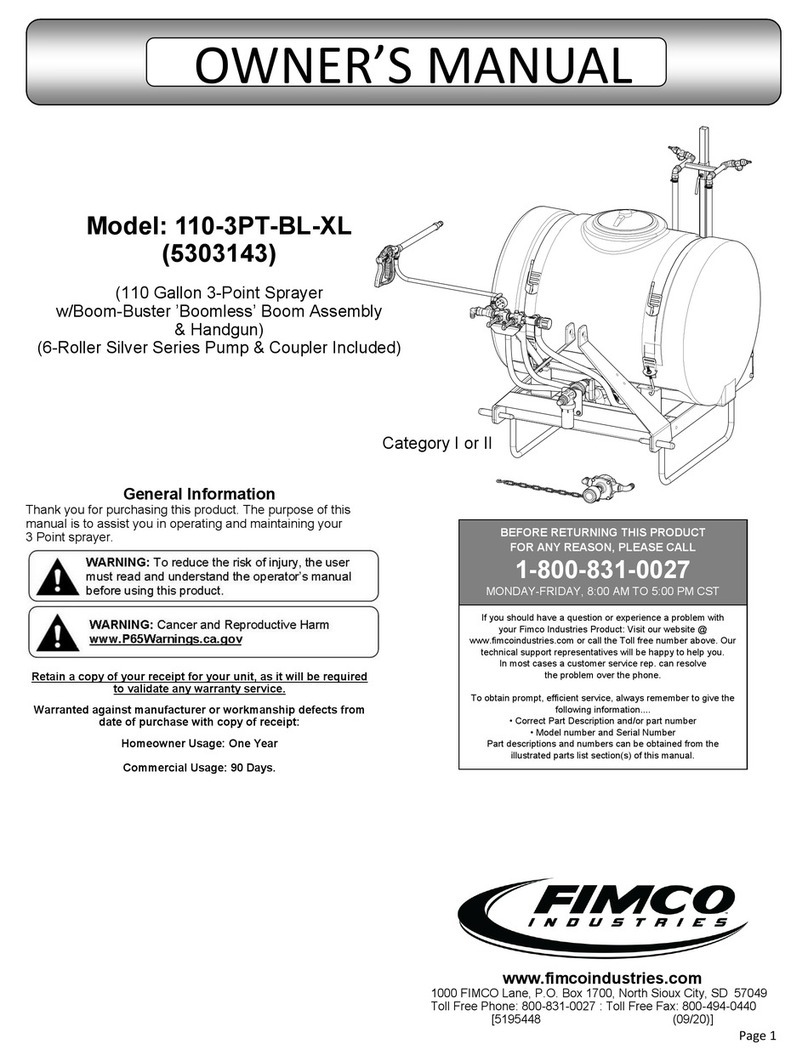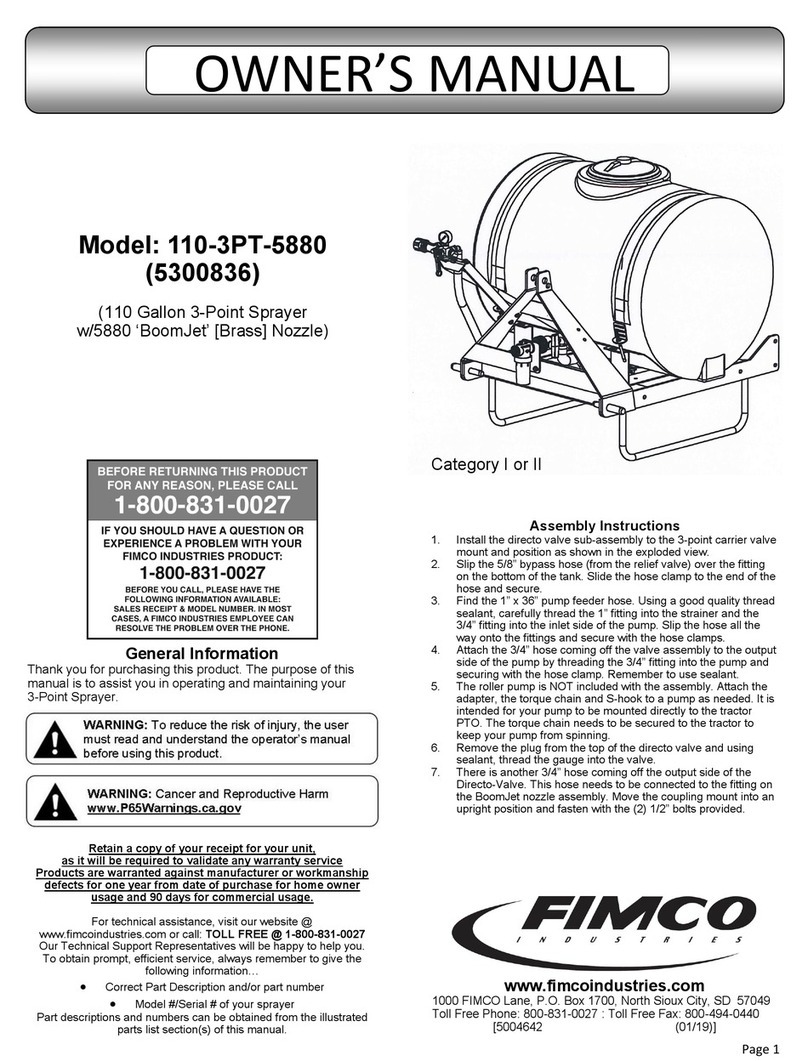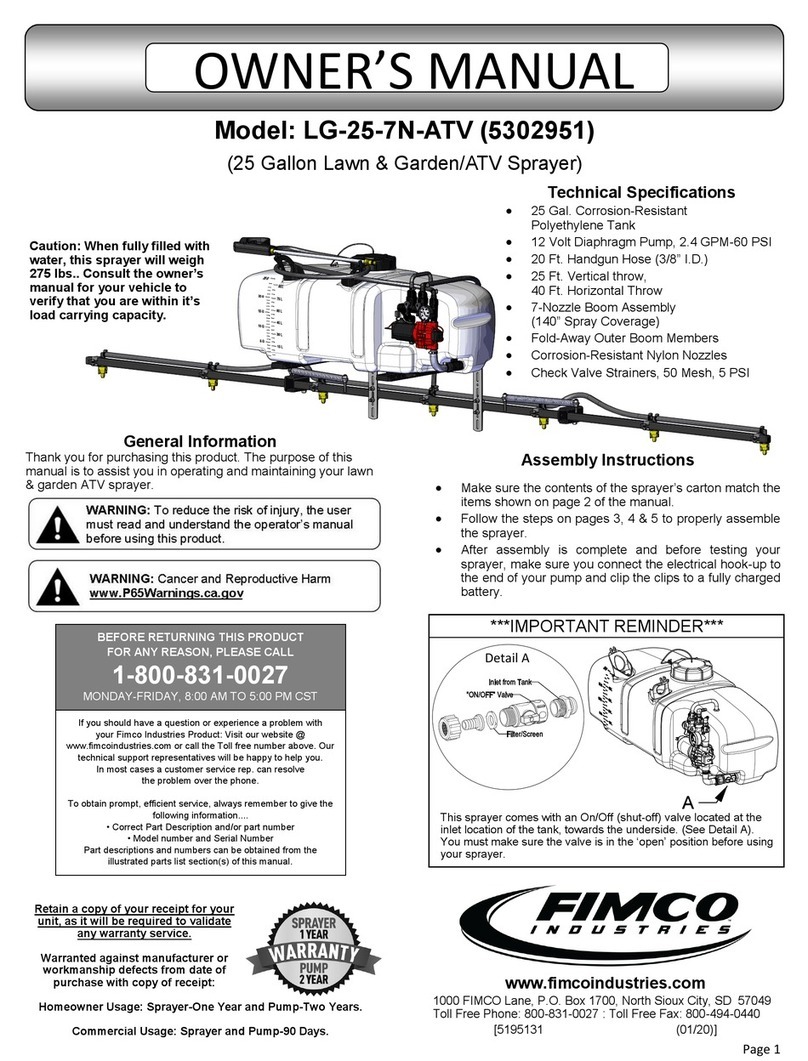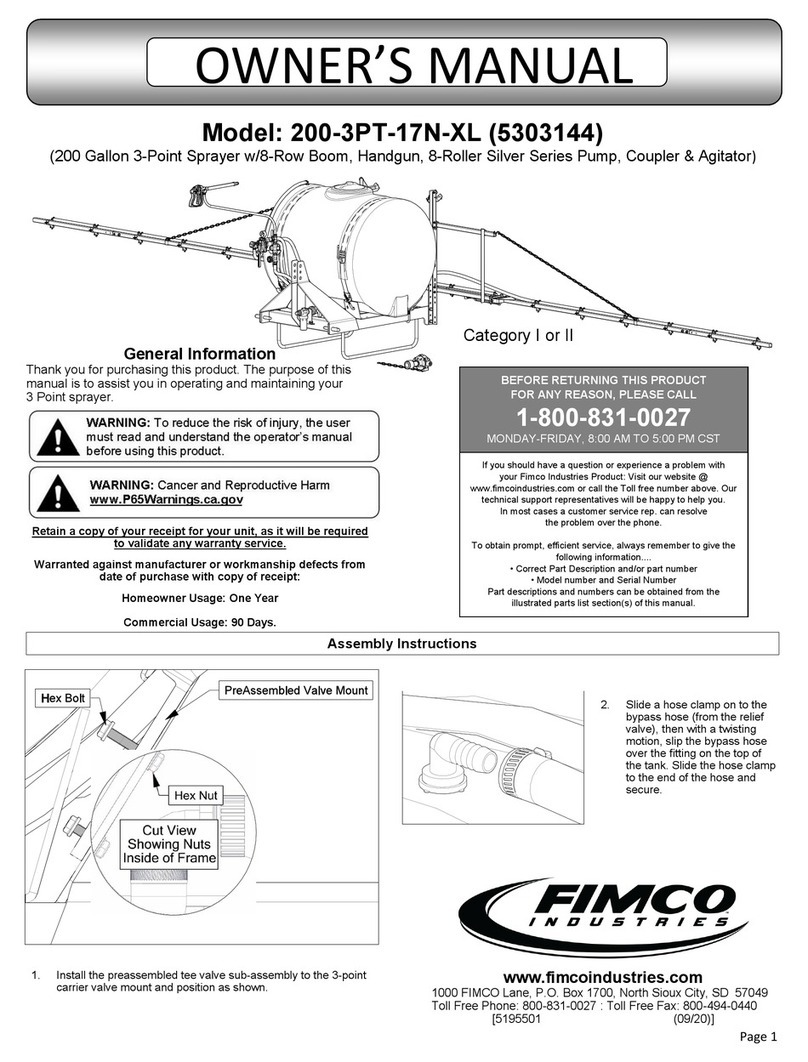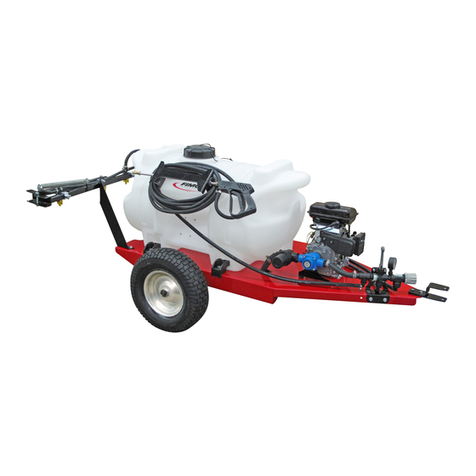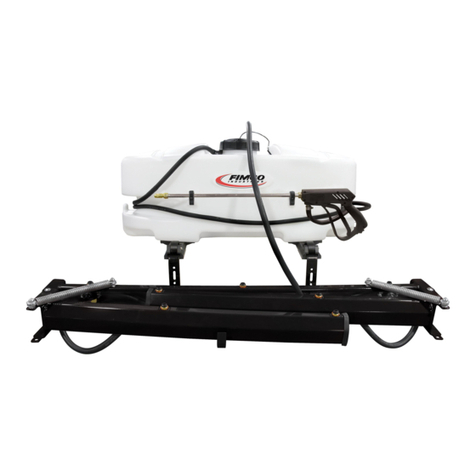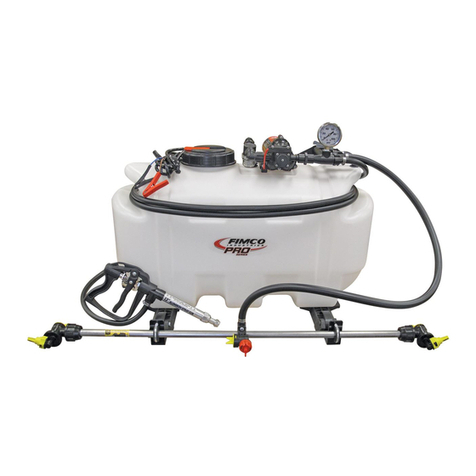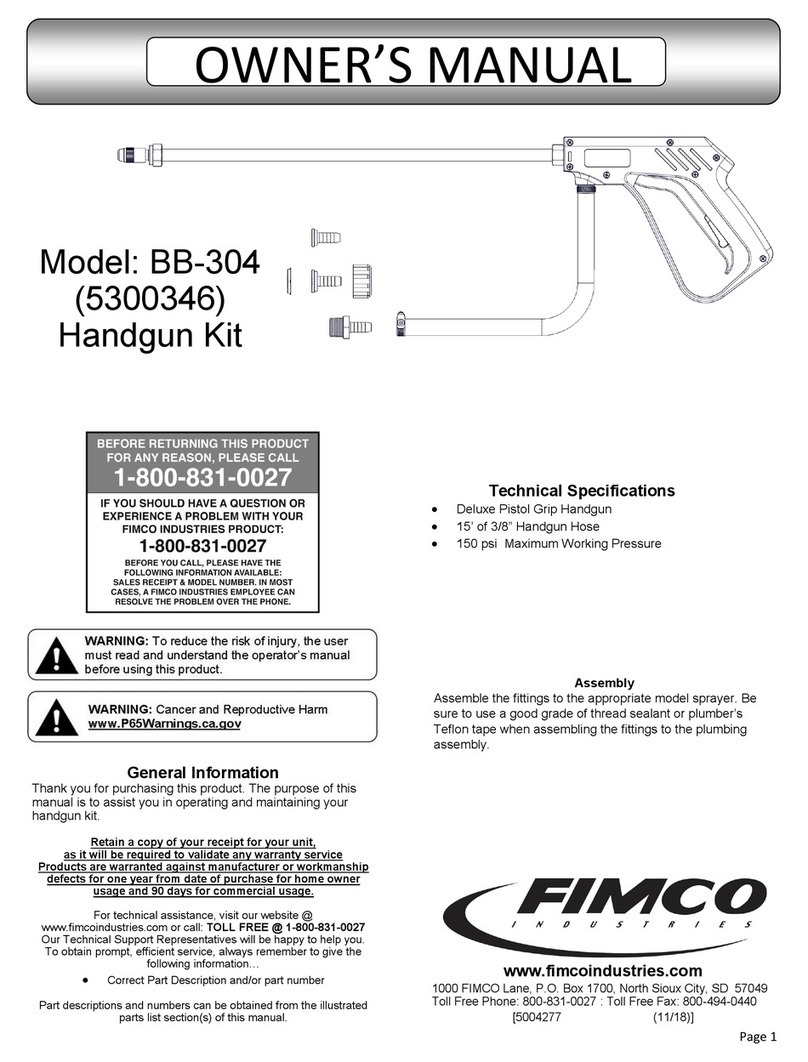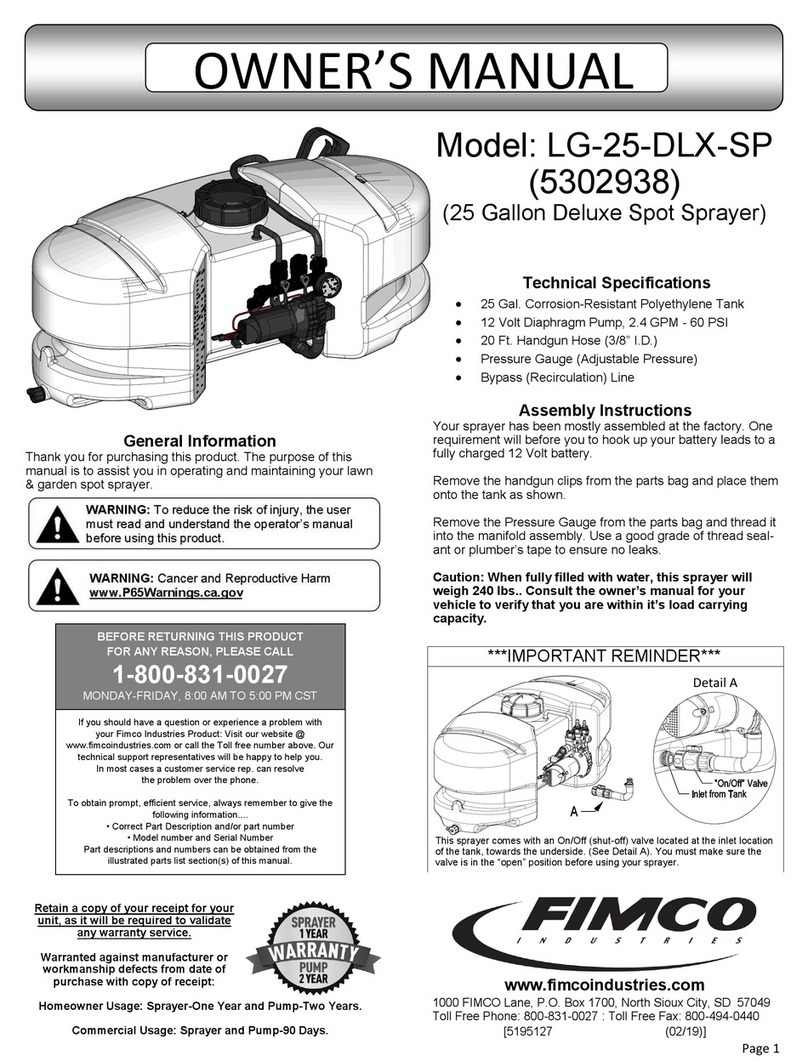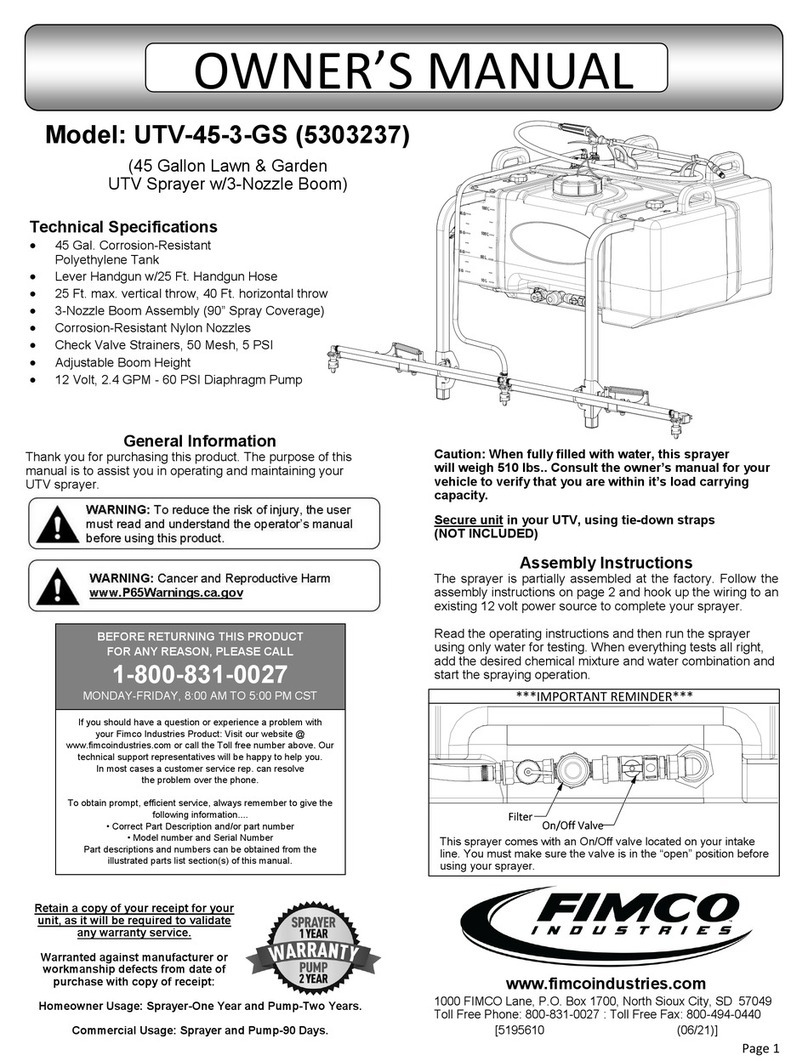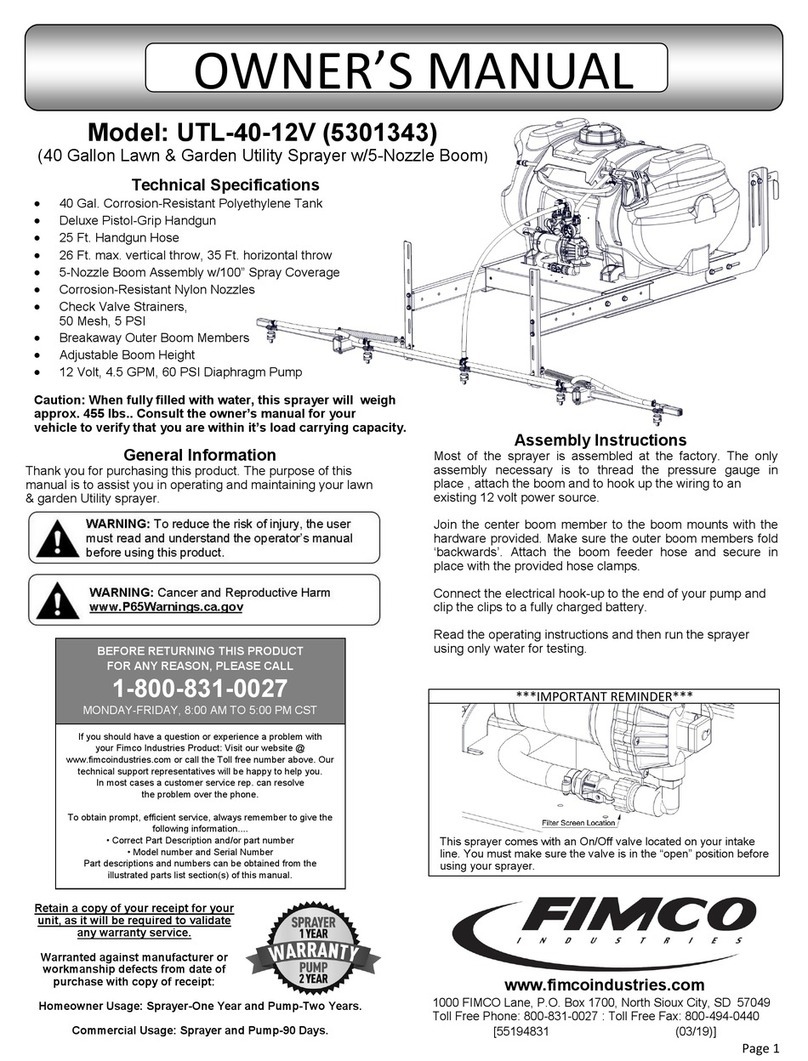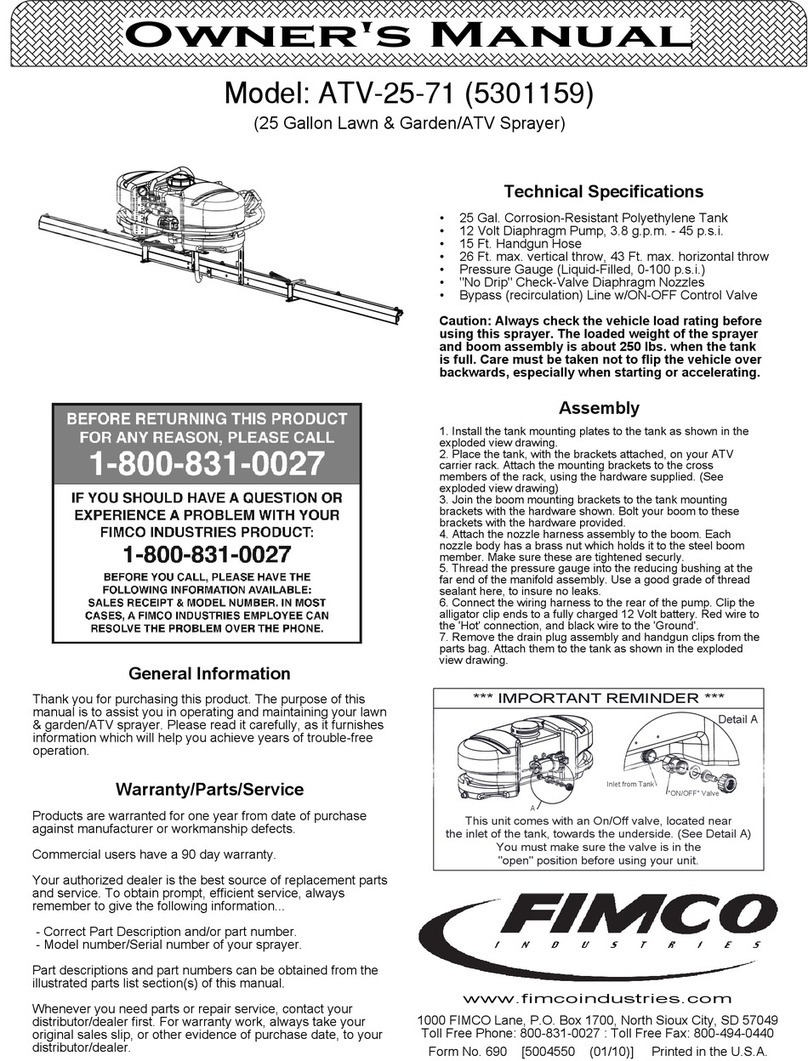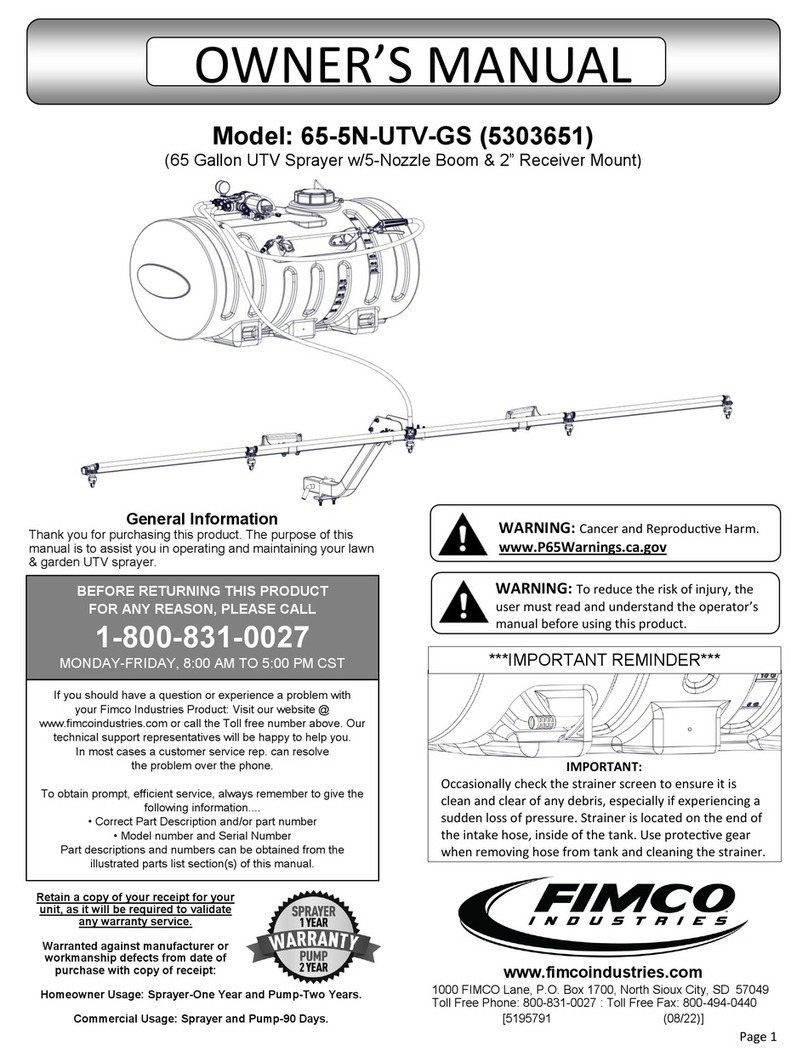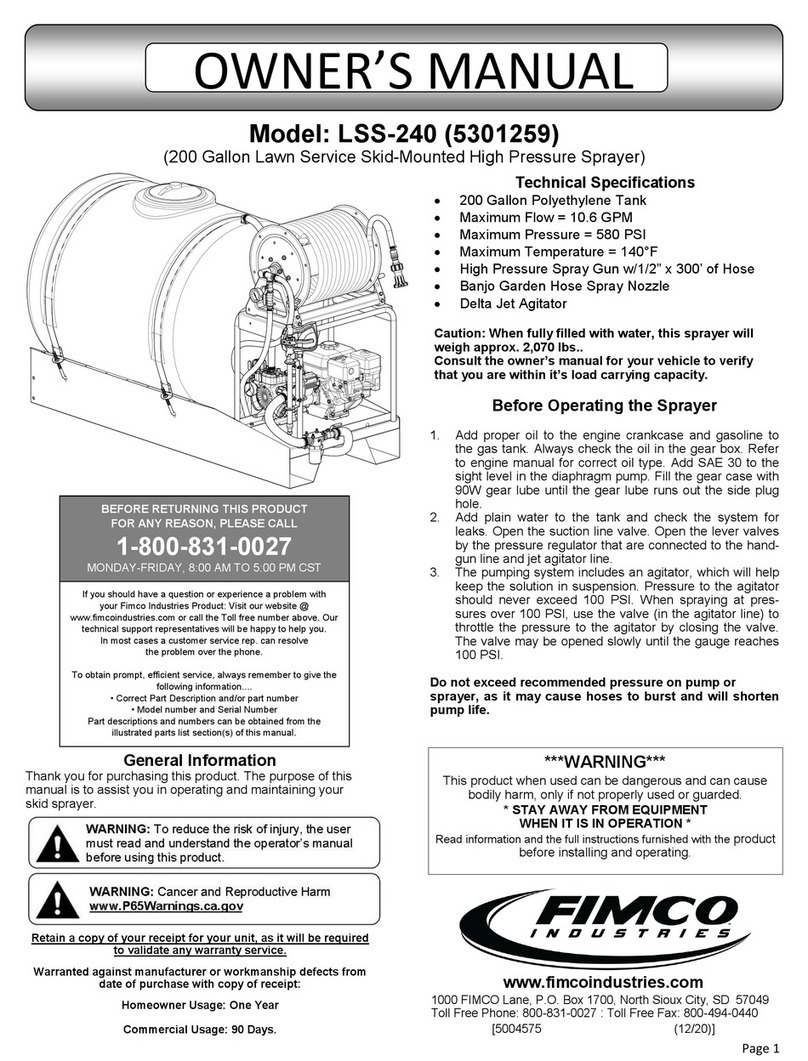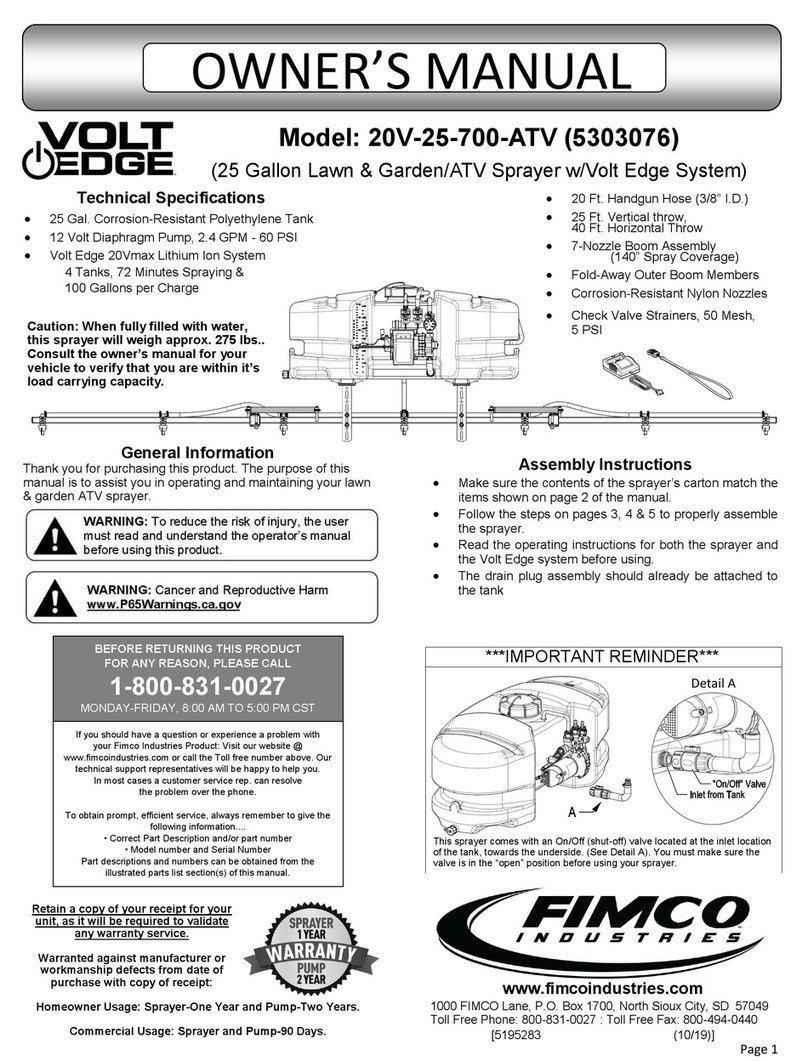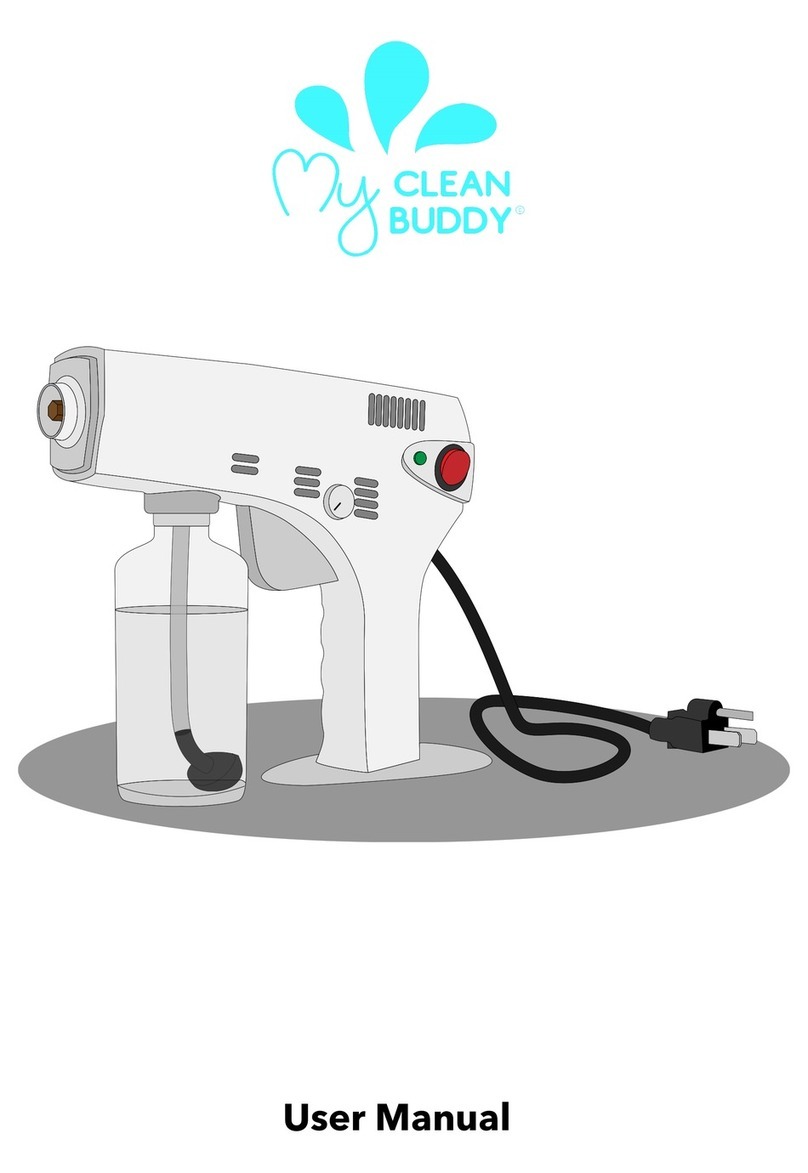
Page 3
IMPORTANT: Remove tank lid and be sure the tank is
clean and free of any foreign material. Rinse tank out
of any tank residue before filling with water to test.
Testing the Sprayer
Attach the sprayer to the tractor 3 point hitch. Mount the pump to the
PTO and affix the torque chain.
NOTE: It is VERY important for to test your sprayer with plain water
before actual spraying is attempted. This will enable you to check for
leaks without the possibility of losing any expensive chemicals.
Fill the tank about 1/2 full with plain water.
Before starting, open the suction line valve (located underneath the
carrier frame), turn the relief valve handle out to lower the line
pressure. This will help prime the pump.
CAUTION: Always be sure that the water (or solution) has reached
the pump before starting your sprayer. If the pump is allowed to run
dry, serious damage to the pump will result.
Always have the pressure line open to the tips so that the air which
may be trapped in the line will be forced (or purged) out.
Start the tractor PTO. Check the entire system for leaks. Once the
pump is primed, the pressure may be increased by turning the
handle of the pressure relief valve in. Keep the pressure line open to
the tips when setting the pressure. Set the pressure and then lock
the relief valve handle in place. Shut off the directo-valve and check
for leaks again. Pressure will increase when the pressure line valve
is closed and then return to the preset pressure when the valve is
opened again.
During the testing period, be sure to observe the spray pattern given
by the spray nozzles. If there is any pattern distortion, it will be
necessary to remove and clean the affected tips.
Caution: Never use a metal object or other sharp item for cleaning a
nozzle tip. It is better to use a nozzle brush (NOT wire brush) or
compressed air for tip cleaning.
Conditions of weather and terrain must be considered when setting
the sprayer. Do not spray on windy days. Protective clothing must be
worn in some cases
Be sure to read the chemical label(s) before application!
Operation & Calibration
The performance of any agricultural chemical depends upon the
proper application.
The tips supplied as standard with the sprayer can be used for a
wide variety of spraying applications. Other tip sizes are available for
different coverages. The speed and pressure charts shown indicate
the rates can be changed considerably by changing speed and
pressure. The pumping system draws solution from the tank through
the strainer/filter and to the pump. The pump forces the solution
under pressure to the boom nozzles.
The (3) nozzles are fixed at 17-1/2” spacing
All (3) nozzles spraying at the same time will allow a maximum
coverage of 30 feet
The center nozzle will spray an 80” swath
Each of the (3) nozzles has a shutoff valve, so you can shut off
each nozzle individually. This may help in achieving the actual
coverage needed for your application.
WARNING: Some chemicals will damage the pump valves if
allowed to soak untreated for a length of time! ALWAYS flush the
pump as instructed after each use. DO NOT allow chemicals to sit in
the pump for extended times of idleness. Follow the chemical
manufacturer’s instructions on disposal of all waste water from the
sprayer.
When you are ready to spray, mix chemicals as follows. Add the
proper amount of water to the tank. Run the sprayer while adding
chemical to the water. Do NOT spray through the boom at this time.
This will allow the solution to return (‘bypass’) to the tank. The
movement of solution through the bypass will aid in mixing the water
and chemicals. If this water movement is not enough to keep the
chemical in suspension, it may be necessary to add an optional
agitator kit. You should now be ready to spray.
Four things must be considered before spraying with the boom.
How much chemical must be mixed in the tank.
Rate of spray (gallons per acre to be sprayed).
What pressure (p.s.i.) will be used.
Speed traveled (mph) while spraying.
Refer to the chemical label to determine your chemical mixture
See the tip chart to determine the pressure to be used. The
chart will also show the speed used when spraying.
Chemical labels may show application rates in gallons per acre,
gallons per 1000 square feet or gallons per 100 square feet. You
will note that the tip chart shows 3 of these rating systems.
Once you know how much you are going to spray, then determine
(from the tip chart) the spraying pressure (PSI), and the spraying
speed (MPH). The pressure can be set by running the sprayer with
the boom nozzles ‘on’ and then adjusting the relief valve until the
gauge reads the desired pressure. Notice that the pressure will go
up when the boom line is shut off. This is normal and the pressure
will return as before when you open the boom line. When selecting
pressure from the tip chart, it is a good idea to try for the 20 or 30
p.s.i. range as this allows an excellent nozzle pattern. Spraying at
10 p.s.i. begins to break up the pattern and at 40 p.s.i. you may
notice some drift.
Determining the proper speed of the pulling vehicle can be done by
marking off 100, 200 & 300 feet. The speed chart indicates the
number of seconds it takes to travel the distances. Set the throttle
and with a running start, travel the distances. Adjust the throttle until
you travel the distances in the number of seconds indicated by the
speed chart. Once you have reached the throttle setting needed,
mark the throttle location so you can stop and go again, returning to
the same speed.
Add water and proper amount of chemical to the tank and drive to
the starting place for spraying.
Speed in M.P.H.
(Miles Per Hour)
Time Required in seconds to travel a distance of
Capacity
(g.p.m.)
(3 nozzles)
1
MPH
2
MPH
3
MPH
4
MPH
5
MPH
6
MPH
8
MPH
Capacity
(g.p.m.)
(3 nozzles)
1
MPH
2
MPH
3
MPH
4
MPH
5
MPH
6
MPH
8
MPH
Capacity
(g.p.m.)
(3 nozzles)
1
MPH
2
MPH
3
MPH
4
MPH
5
MPH
6
MPH
8
MPH
Gallons per Acre Based on Water - 17 1/2" Spacing
Note: The same figures are used for 1, 2, or 3 nozzles.
Gallons per 1000 Sq. Ft. based on Water - 17 1/2" Spacing
Gallons per 100 Sq. Ft. based on Water - 17 1/2" Spacing

